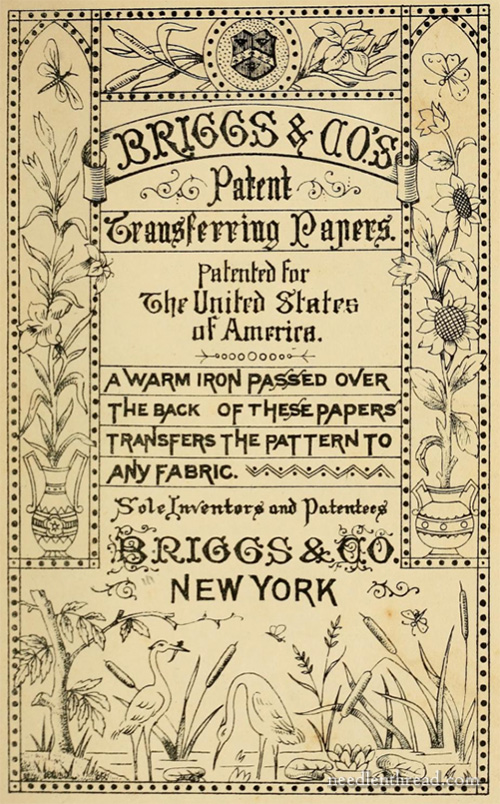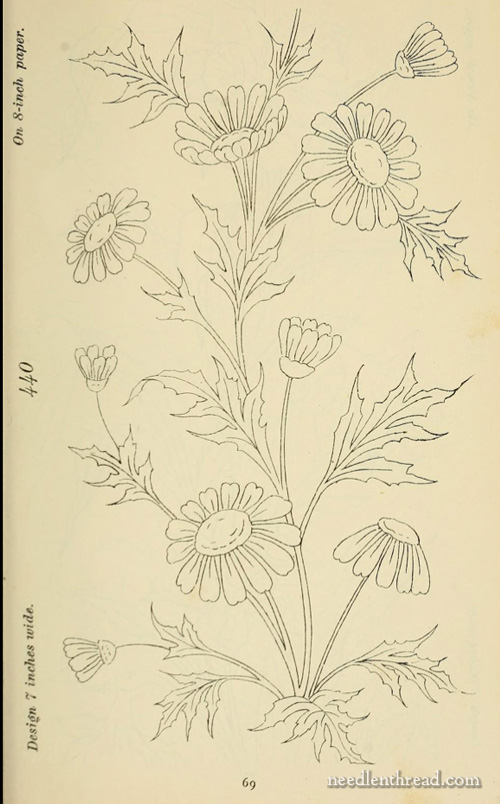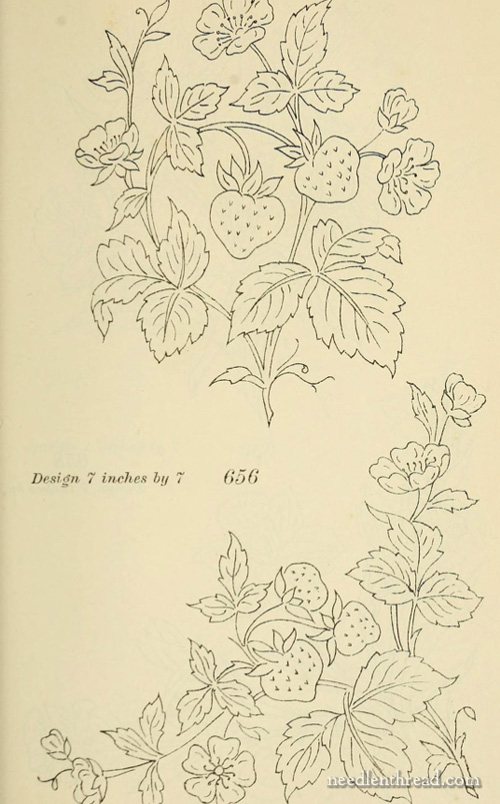I was reading an old needlework book the other day, published in 1907, when I came across a section on design transfer for embroidery. It began thus:
The transferring of designs on to the material is at no time a very easy occupation, and is certainly one which most people prefer to have done for them.
Some things haven’t changed much since 1907, methinks! Most of us who embroider for relaxation, for enjoyment, as a creative outlet, and even for a living are faced at one point or another with having to get a design onto fabric. For some, it can be a monumental deal-breaker. “If I have to transfer that, forget it.”
And while there are folks today who (hilariously – it always makes me chuckle!) will spurn iron-on transferring as if it is some kind of innovative, unworthy, inaccurate, or even harmful method of transfer (despite the massive leaps and bounds of ink science in recent decades), iron-on transfers have been the friend of the embroiderer for a long, long time.
Way back decades and decades – we can almost say centuries ago, and certainly longer than a century ago – methods of transferring embroidery designs were revolutionized by the iron-on transfer. And we continue to enjoy the benefits of the iron-on transfer today, thanks to those early pioneers in the process.
One of those pioneers was Briggs & Co.
In 1880 – that’s 141 years ago! – Briggs & Co published their catalog for patented iron-on embroidery transfers here in the US.

The Briggs & Co catalog is a wonderful collection of 19th century embroidery designs that I’ve written about before here on Needle ‘n Thread. But I think it deserves highlighting.
Embroiderers in the late 1800’s could refer to the catalog for designs they were interested in, and then place mail orders for the transfer papers. The designs in the catalog were not necessarily the size of the actual transfer, but size was clearly indicated so that the embroiderer knew what to expect.
In some regards, the approach to iron-on transfers hasn’t changed much, but in others, the instructions for use of the transfers were quite different from what they are now.
The science of ink has progressed quite a bit since then, making transfers today much more reliable. Plus, we have electric irons! Oh, what a wonder! Sometimes, it’s easy to forget that life was not always as it is now.
Ladies, with a taste for designing, can form beautiful groups of cutting and arranging flowers, &c, from various patterns. To do this most effectively, gum the small pieces (when cut) on to a sheet of paper, arranging them as desired, and, when the group is formed, transfer in the usual method.
If the iron be a little too cold, the design when transferred does not adhere firmly to the fabric, and is apt to rub off; in this case, hold the back of the work to the fire for two or three seconds, and the color will be at once permanently fixed.
If the iron be too hot, the composition will be too much dissolved and appear to spread only upon the tissue paper, whilst in reality it has been absorbed by the fabric; in this case, a little friction with the finger nail, or a small hard brush, will bring the design distinctly to the surface.
So, was your iron too cold? Hold the back of the embroidery up to the fire!
Was your iron too hot? Does it look like the ink dissipated completely? Add some friction and the design will appear.
Curious, isn’t it?

The original catalog is full of lovely designs that can still be used today with very little “dating” to them. Sure, some are dated, but others are timeless.
I’d like to say this is the daisy design we’ll be working through in the next series of tutorials that will be springing up here on Needle ‘n Thread very soon, but in fact, it’s not.
It’s a little too complicated for our series – but once we work through the upcoming daisy series together, you’ll have all the confidence you need to tackle the beautiful spray above!

If you worked through the strawberry series recently, you might want to take on something a little more grand, strawberry-wise, and Briggs & Co can supply you with a drawing.
And while you can’t order their iron-ons, you can definitely find their designs in their catalog, for free, online.
You’ll find the catalog here, on Internet Archive.
You can save it to your computer as a PDF, print any page you want, enlarge the page (if you want) with a photocopier, trace over the lines to darken them, and then trace the design onto your fabric (or use your favorite design transfer method).
It’s not a bad way to have access to some very pretty embroidery designs – for free!
So, there’s a little weekend rabbit hole for you. I hope you enjoy the publication on Internet Archive and that you have a lovely weekend with your needle and thread!







Oooh, downloaded the catalog! I can see a lot of awesome scrapbooking uses for those images, as well! Maybe even incorporating some of them into needlelace designs.
Is there any kind of iron on transfer design that can wash out later? For me, that would be a real dream come true!
Some can under certain circumstances, but most don’t.
Thanks, Mary! What a great resource for a designer who loves flowers.
OMGoodness Mary, what a treasure. I’ve downloaded it but it keeps hesitating as I scroll, don’t know why but at least I can’t whiz through it too fast. Thank you for this treat.
Happy stitching – Brenda
Mary – what an incredible resource!! Thank you so much for sharing. And I was tickled by the spelling of D’Oyleys!
Yes, that always cracks me up! 🙂
Thanks for sharing this-it’s just in the nick of time for me. I’m thinking about a new project, but feeling incredibly lazy about design. Problem solved!
I have amassed a significant collection of original iron on designs. While some have dates on them (I have 1933, 1937 and 1958 designs). I would love a resource to date the designs or at least share the beautiful images with you.
Thank you Mary. I love that particular rabbit hole, and have enjoyed many hours there, plus the Antique Pattern Library. Enjoy your weekend.
I love iron-on patterns. The Briggs catalog cover is. I love embroidery with a bit of history. How cool it would be to iron transfer that cover onto some nice linen and stitch it’s beautiful flowers and water birds. And that script would make it a sampler of a sort straight out of embroidery history. I love it.
Wow!
Do you know if there’s something similar for their Penelope Jacobean Embroidery patterns circa 1950?
I’ve got a couple of their catalogues (similar contents), but I suspect there were more.
Or examples of their catalogues available online?
Many thanks for all your hardwork – I learn so much, but have yet to put most of it into practice. In time
Best wishes
Sue
Anything circa 1950 would still be under copyright, I’m afraid. 🙂
Your best bet is digging through Internet Archive or Antique Pattern Library. The latter hosts a fabulous collection of public domain antique books with designs, techniques, etc., for download.
Dear Mary, those designs are delightful! I have just enjoyed flicking through that online catalog and have saved it to hopefully print out and use some of the patterns. The botanical floral patterns are really lovely and very inspiring. Thank you for sharing!
Please help. I’ve gone to the Archive site to see the Briggs…. I’ve even signed in making a new account for myself but I don’t find any place where I can download the catalog. What am I missing?
Hi, LJ – You don’t have to sign in on Archive. If you scroll down the page, on the right side of the page, you’ll see a box that says “download options” – click on the PDF option.
Wow!!! LOve those old books. Hours of fun for sure.
bm
Dear Mary
Brigg’s & Co look like a great resource and the strawberry and daisy patterns you picked are lovely designs and as you say you could use the stitches from the strawberry and the up and coming daisy series on the designs above which would look lovely. Thank you for sharing with us the Brigg’s & Co designs and for the link to the Internet Archive and for the photos.
Regards Anita Simmance
Hello!
My 11 year old daughter is needing to do a report about and complete a small project that is authentic to the United States in the 1880s and 1890s. She is considering the topic of embroidery. We are trying to find out if these types of patterns would have been completed using different colors of thread or all one color?
She will be a junior docent at a local historical site this summer and wants to embroider a flour sack to carry in her basket. We think these patterns are perfect, but would like to find out what a completed project in the American West in that timeframe may have looked like. In the meantime, we are continuing to look online to see if we can find examples of simple embroidery in that timeframe.
Thank you!
Kirsten (& Victoria)
Hi, Kirsten – Yes… they would have been embroidered in color, using silk for the most part. I don’t know that they would have been embroidered on flour sack towels, though. These are more akin to the “society silk” type designs of the later 1800’s through the early 1900’s. It wasn’t really until the early 1900’s and on through the Depression that the flour sack towel became something that was used as a base for stitching or clothing, as far as I know. They were certainly used in households during the 1800’s, because people simply didn’t waste things, but the sacking was purely for functional use at that point, I think. Then again, that’s not to say that here and there, people didn’t get creative, even if there aren’t too many early examples of that kind of use for sacking. If it’s a textile, eventually someone is bound to embellish it!
I actually have an original patent book and now that I read your section above understand how it was used. In fact it’s like an order book…. Thanks
Hi I have just found some these designs in a box from my grandmother. in the uk.
Briggs Transfer no. 51239 Class D and Dorset Feather Stitch NO 51235 Class D
Is there away of finding out more with the numbers, when the design was created etc.?
Thank you
Hi, Su – thanks for your note! I don’t have any information on that, but hopefully someone else will read your question and be able to help!